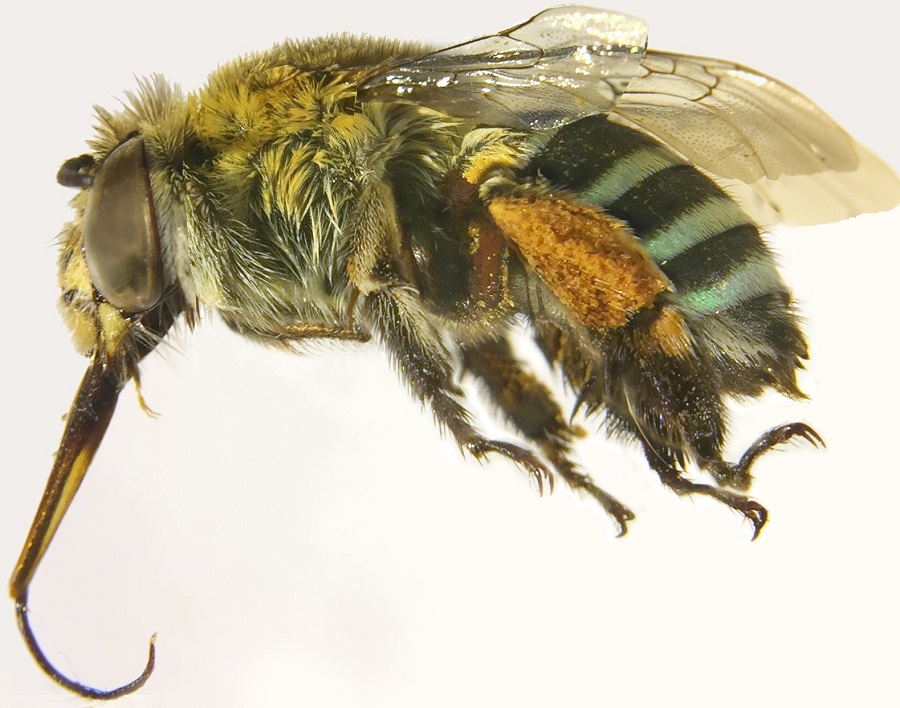We’re researching pollinator networks in Kosciuszko National Park, home of our ski fields, by mapping out a network of interactions between plants and their pollinators using new DNA technologies, including pollen DNA metabarcoding.

A blue-banded bee, Amegilla (Zonamegilla) asserta, from the Australian National Insect Collection. This specimen was collected in 1971 and still has pollen stuck to its legs. Photo by Juanita Rodriguez Arrieta.
A native blue-banded bee, collected in 1971, which still has pollen stuck to its legs.
Australia’s tourism industry depends on our unique biodiversity. Seventy five per cent of our species are found nowhere else on earth.
Biodiversity gives us iconic animals, sweeping vistas and natural places to enjoy: beaches, deserts, forests, reefs and even our ski fields. As we head into winter in our alpine areas, biological diversity is at work creating and maintaining the natural environment.
Sheltering in leaf litter and underground are fly larvae, some feeding on decaying plant matter, some on other insects. In spring and summer they will emerge as adults and feed on pollen and nectar, pollinating alpine plants at least as well as any honeybee might.
“Horseflies are great pollinators because they’re so hairy,” says Bry the Fly Guy, also known as Dr Bryan Lessard of the Australian National Insect Collection.
“Flies are the unsung heroes of pollination. Recent research from University of New England shows the common blow fly can carry more pollen stuck to its body than a honey bee,” he says.
“It’s true that female horseflies will take a blood meal now and then because they need the proteins in blood to ripen their ovaries. Most of the time they feed on flowers, but exactly what they pollinate is a bit of a mystery,” he says.
Both biodiversity and food security depend on pollination of native plants and crops. It’s a critical service worth billions of dollars and is performed mainly by insects, who visit flowers to feed on pollen and nectar, transferring pollen from the male to female flower parts of the flowers they visit, thus enabling plants to produce seed.
Around the world, pollinators are declining. They face threats such as land clearing, habitat fragmentation, pesticides and climate change. Honeybees are experiencing colony collapse disorder.
As part of our Environomics Future Science Platform, we’ve decided to quantify pollination services in Australia.
To begin we’re researching pollinator networks in Kosciuszko National Park, home of our ski fields, by mapping out a network of interactions between plants and their pollinators using new DNA technologies, including pollen DNA metabarcoding.
“We’re using historic natural history specimens and field data from the area to unravel the past structure of pollen transport networks in Kosciuszko,” says Francisco Encinas-Viso of the Australian National Herbarium.

Photo of a daisy, Craspedia sp., taken in Kosciuszko National Park by Alexander Schmidt-Lebuhn.
A daisy in Kosciuszko National Park being visited, and perhaps pollinated, by a fly.
“Many of the bees, wasps and flies in the Australian National Insect Collection that were collected as long as 40 or 50 years ago have pollen still stuck to them. We can use pollen DNA to identify the plant species they visited and match this up to field data and plant specimens in the Australian National Herbarium,” he says.
“When summer comes, we’ll head back to the same areas of Kosciuszko National Park, collecting plants and insects to find out how plant-pollinator communities have changed in the last decades.
“Ultimately, what we’d really like to know is whether there are keystone species for ecosystem functioning and crop pollination in different areas of Australia,” he says.
It’s not the first time scientists have studied plant-pollinator interactions, but in the past they relied on laborious and less reliable techniques, like watching flower visitation or identifying pollen on captured insects by looking at in under the microscope.
Our Environomics Future Science Platform, short for environmental genomics, is using new DNA technologies to transform environmental science. Developing the tools to improve our understanding of plant-pollinator networks will be crucial for managing threatened and changing habitats, improving conservation and protecting food security through crop pollination.
Find out more about our Environomics Future Science Platform.


28th April 2018 at 6:54 pm
Hello from Kent, England: we keep 4 hives; two with native black bees, the others of course are the the yellow species; and we find as prolific honey producers (so far, that is!) Wonderful to read about Australia’s bees…Is there a Guide for all the species?
Best wishes
Ray Lee
30th April 2018 at 10:32 am
Hi there, Ray
With a quick Google, there are a few Australia-specific bee guides:
– ‘The Australian Beekeeping Manual’ (Owen, 2016)
– ‘The Australian Native Bee Book’ (Heard, 2015)
Hope this helps.
Thanks,
Jesse
CSIRO Content Team
Pingback: Why it's so hard to swat those annoying flies | editionamerica
8th February 2018 at 10:31 am
Get them during their vanity moments. They pause, start making s fuss of their face without looking…wait, wait … SWAT!
Pingback: Flies have among the many quickest eyes on Earth — so it is no marvel they're laborious to swat